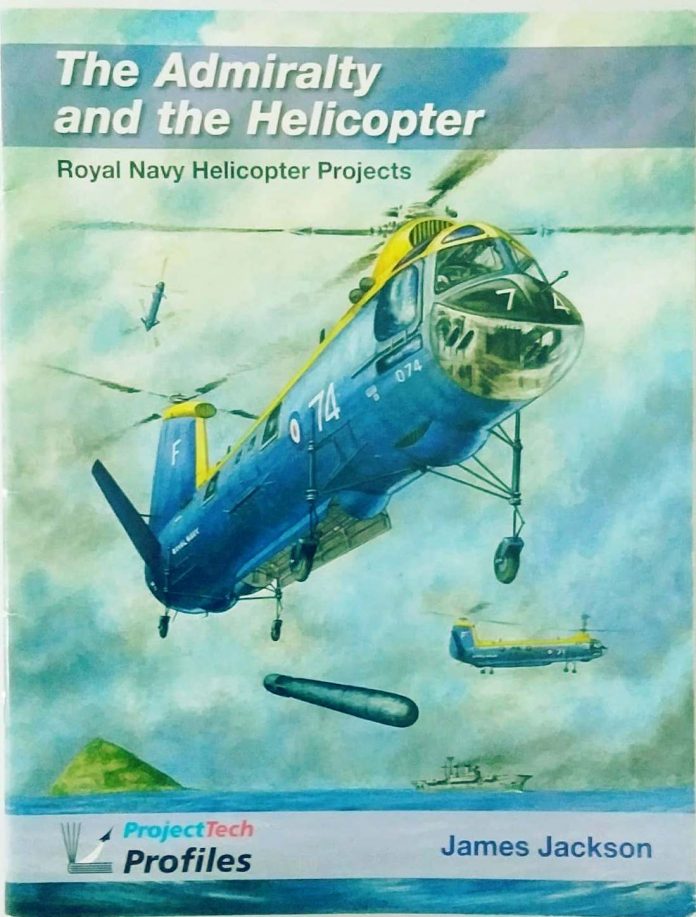
The Admiralty and the Helicopter: Royal Navy Helicopter Projects. By James Jackson. Blue Envoy Press, 2018, Paperback, ISBN 978-0-9561951-4-2
Reviewed by CDR Mark R Condeno, Philippines Coast Guard Auxiliary
This year marked the 75th anniversary of the introduction of the helicopter to the Royal Navy Fleet Air Arm in 1944 when a select group of pilots went to the United States to train on one of Sikorsky’s earliest rotary winged craft. The use of helicopters at sea developed substantially during the Cold War for anti-submarine warfare.
The potential of the helicopter as a combat platform was proven during the Korean War and later during the 1950s and this new publication from Blue Envoy Press provides an in-depth look of Royal Navy Helicopter Projects from the Fifties up to the present.
As part of its “Project Tech Profiles” series author James Jackson delivers an account of the Royal Navy’s quest to use the helicopter as an ASW platform and a Commando insertion craft. The book is divided into five chapters commencing with a run through of the pioneering days of the evolving nature of submarine and submarine warfare during the 50’s. Some hitherto unknown information to this reviewer is provided, such as the Admiralty’s early experiments with rotary wing aircraft that dated back to 1935. The opening chapter titled ‘Searching for the Single package’ pertains to the Admiralty’s quest for a dual mission as a Search and Strike helicopter. The types covered are the Sikorsky and Westland Whirlwind, Sikorsky S-55, Bell’s HSL and the Bristol Type 191. This chapter provides the reader with a technical background on the Admiralty’s single package concept. Apart from ASW, Commando insertion and raiding utilizing the Wessex is also covered; eight of which were lost during the Falklands conflict.
The second chapter looks into the Manned Torpedo Carrying Helicopter or Match and its compatibility with smaller warships such as the Frigate in which the Type 12 (HMS Whitby), Type 14 (HMS Blackwood) and Type 81 (HMS Tribal) which entered Royal Navy service during the mid to late 1950s. Readers would be surprised of the proposed use of ultralights in the ASW role, as well as the Saro P531 and Westland Wasps. Similar to the earlier section, the compatibility of the weapons and related systems with the helicopter is discussed.
The advent of the 1960s, with new submarine threats emerging, called for new weapons systems and the replacement of old ones. The Air Staff’s OR 358 and the Admiralty orders AW165T were merged to become NASR.358. This called for a multi-purpose helicopter to replace the Westland Wessex and Bristol Belvedere then in service. Several contenders were covered – from Boeing Vertol V107, the French Super Frelon, Sikorsky’s S-61 and S-65, the Sea Stallion, Boeing CH-47 Chinook and the Westland WG.1 which resembled the CH-46 Seaknight. Of note is an earlier proposal of a vertical take-off and landing (VTOL) type aircraft with a circular wing.
The fourth chapter covers the Westland Wildcat (two of which were commissioned by the Philippines naval air wing several months ago). This segment investigates the Westland Lynx and subsequent development to the Super Lynx and later, the AW159 Wildcat. Succinct entries provide vignettes on the Sea Skua Missiles carried by the Lynx, Marconi Stingray Torpedoes and anti-surface guided weapons.
The penultimate part investigates the replacement of the Westland Sea King which was retired from the RN last year coinciding with the publication of this book. In this section readers will appreciate the amount of data on the WG.34 ASW helicopter project, notably the artist’s impression of the design. The end pages tackle the Joint Helicopter Command and the Augusta Westland EHI 101 Merlin which replaced the Seaking in its role as a medium transport and ASW helicopter.
This reviewer strongly agrees with the author’s conclusion of the pivotal role to be undertaken by the Merlin and Wildcat once HMS Prince of Walesand HMS Queen Elizabethare fully operational in the multi-mission threat environment of the present and future.
Mr Jackson and the publisher Blue Envoy Press have achieved their goal in documenting the integration of the helicopter and the ship in the RN. The chronological timeline of the helicopter projects serves as an aid to understanding the period discussed in the book as well as the specifications and operational requirements details. The book’s strengths include 58 colored and black and white photographs, 20 drawings, three artists’ impressions and two diagrams which enhance the book, supplemented by a three-page index.



